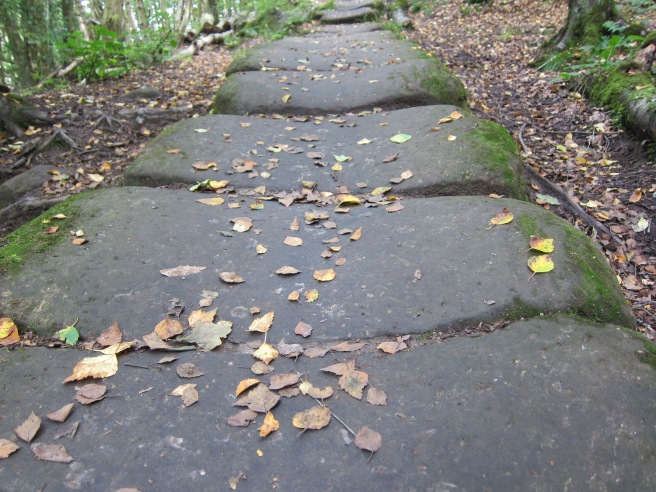Vestigium, vestigi(i): a footstep, step, footprint, foot-track, track[1]

Our modern English ‘vestige’ is a descendant (via Old French) of the Latin vestigium, which means footstep or footpath. A footpath really is a vestige; the physical remnant of the passing of people through a landscape. It takes a lot of journeys to stamp a footpath into the landscape, although they don’t all happen at the same time: the different travellers may never meet one another, but their cumulative journeys create a legacy of their passing. If for whatever reason people cease needing or wanting to travel that way, the footpath is eventually reclaimed by the landscape, leaving only a vestige of the vestige.
I’ve recently been on a walking holiday for the first time (though I hope not the last). We walked St Hilda’s Way, which is a fairly new route formed by linking a number of existing footpaths together; you can find out more from the Whitby Deanery website. I’d read an article in The Guardian about the walk almost exactly two ago and had hankered after following the route ever since. When, like Chaucer’s pilgrims, we felt a yearning to strike out on foot (funnily enough, this yearning did strike at the same time as Aprill’s shoures!) the three-day route, dedicated to one of my favourite early medieval saints and in such a beautiful and history-filled part of the UK, seemed an obvious choice. The route, beginning in Hinderwell, takes you ‘the long way’ to Whitby (about 8 miles as the crow flies, but around 40 following the Way).
This is not one of Britain’s ancient pilgrimage routes, but parts of it have a long history. Most of day one was spent walking towards Danby Beacon; the current beacon is a modern one but the first was constructed in the seventeenth century. Later the site was an RAF radar station; warning systems both early modern and modern! We passed the site of the now-disappeared Grandmontine Priory near Grosmont village (no prizes for working out the etymology!) and views of Whitby Abbey dominated the final day of the walk. I was particularly captivated, though, by the paths themselves.
Parts of the walk follow paths which are known locally as ‘trods’, footpaths which have been surfaced with slabs of stone. Ok, so perhaps a surfaced path isn’t that exciting (we all use pavements every day!), but it was the context of these ones which was interesting. The trods snake for miles up and down the hills, through thick woodland and open fields, but are rather distant from the modern roads. Apparently, some sections date to medieval times, although most are likely to be more seventeenth-to-nineteenth century (I couldn’t find much to read on them, hence the very vague dating here!) Some sections, such as that from Sneaton to Whitby, are known as Monks’ Trods, the assumption being that they were constructed to connect the Abbey to its granges. Some of the slabs are very worn, to the point that they are now quite difficult to walk on, and so instead footpaths have been carved into the ground next to the trod. In other places the route is clearly less-travelled and the slabs of the trod emerge through long grass or are obscured by tree roots, only a mere suggestion of the routeway which was once there.
Really, most of the paths we follow every day are long-established ones which have been trodden for centuries. As part of my journey to work every morning I follow a section of a Roman road, albeit one which is tarmacked and has plenty of traffic rumbling down it. But the gravity of the routeways marked by the Eskdale trods has shifted, leaving only the trods themselves behind, vestiges of vestiges, to which we added our own vestigia.
Acknowledgements
With thanks to my mother-in-law who took this idea of a walking holiday and ran with it, booking all the accommodation and planning our mileage each day, not to mention hobbling on with terrible blisters but nevertheless making it right through to the end!
[1] Lewis and Short’s Latin-English Lexicon, via Logeion, an invaluable research tool for working with Latin and Greek sources. It allows you to simultaneously search different dictionaries at once, and helped me a lot with close reading for my PhD thesis.